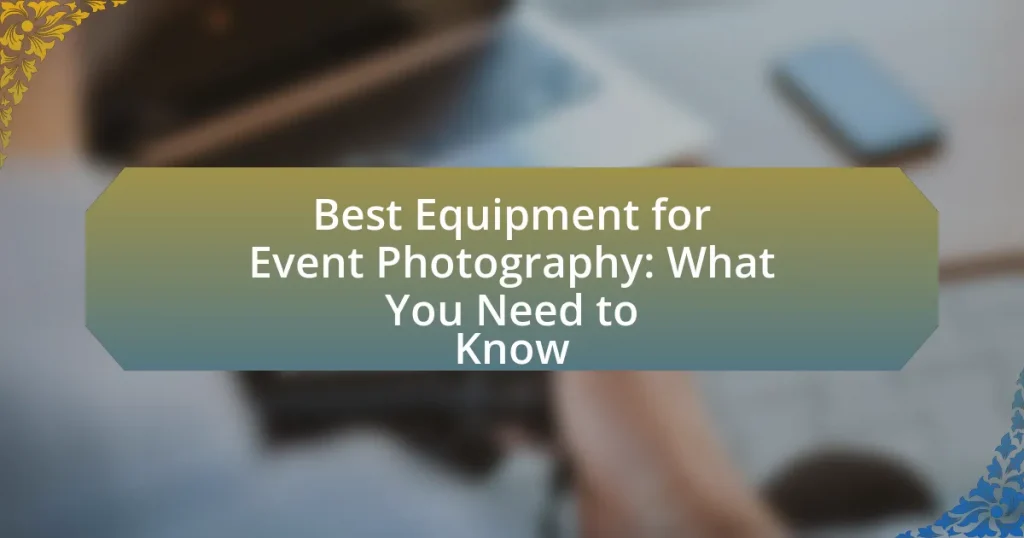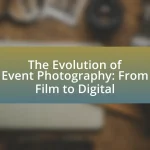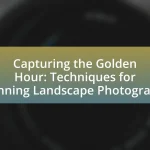The article focuses on the best equipment for event photography, emphasizing the importance of selecting high-quality cameras, lenses, lighting, and accessories to achieve professional results. It discusses the advantages of using DSLR and mirrorless cameras, versatile lenses like 24-70mm and 70-200mm, and essential accessories such as external flashes and tripods. The article also highlights how equipment choice impacts image quality, particularly in low-light conditions, and outlines best practices for managing gear during events. Additionally, it addresses common mistakes to avoid and practical tips for capturing candid moments effectively.
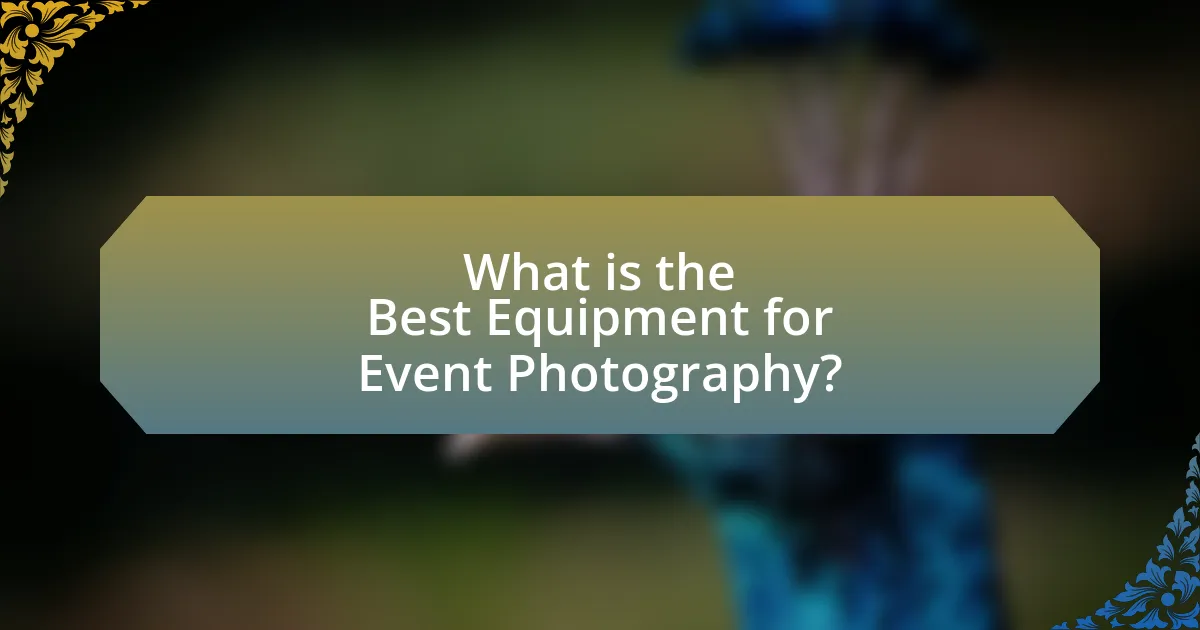
What is the Best Equipment for Event Photography?
The best equipment for event photography includes a high-quality DSLR or mirrorless camera, versatile lenses, a reliable flash, and a sturdy tripod. A camera like the Canon EOS R5 or Nikon Z6 II offers excellent image quality and performance in various lighting conditions. Lenses such as a 24-70mm f/2.8 provide flexibility for different scenes, while a 70-200mm f/2.8 is ideal for capturing subjects from a distance. A flash, like the Godox V1, ensures proper lighting in dim environments. Additionally, a tripod stabilizes shots during low-light situations. These choices are supported by industry standards, as professionals often recommend these models for their reliability and performance in event settings.
Why is choosing the right equipment crucial for event photography?
Choosing the right equipment is crucial for event photography because it directly impacts the quality of the images captured. High-quality cameras and lenses enable photographers to effectively handle various lighting conditions and fast-paced environments typical of events. For instance, a camera with a larger sensor can perform better in low light, which is often the case during evening events, while a versatile lens allows for quick adjustments to framing and focus. Additionally, using appropriate accessories, such as tripods or external flashes, can enhance stability and lighting, further improving image quality. Therefore, the selection of equipment is essential for achieving professional results in event photography.
What types of events require specialized photography equipment?
Events that require specialized photography equipment include weddings, concerts, sports events, and corporate functions. Weddings often necessitate high-quality cameras and lenses for capturing moments in varying lighting conditions. Concerts demand equipment capable of handling low light and fast motion, such as high ISO cameras and fast lenses. Sports events require fast shutter speeds and telephoto lenses to capture action shots from a distance. Corporate functions may need specialized lighting and equipment for video recording to ensure professional quality. Each of these events presents unique challenges that specialized equipment can effectively address.
How does equipment choice impact the quality of event photos?
Equipment choice significantly impacts the quality of event photos by determining factors such as image clarity, low-light performance, and versatility. High-quality cameras and lenses can capture sharper images with better color accuracy and detail, especially in challenging lighting conditions typical of events. For instance, a camera with a larger sensor, like a full-frame DSLR, can produce superior images in low light compared to a smaller sensor camera, as evidenced by studies showing that larger sensors reduce noise and enhance dynamic range. Additionally, the choice of lenses affects depth of field and focal length, allowing photographers to create more compelling compositions. Therefore, selecting appropriate equipment directly correlates with the overall quality and aesthetic of event photography.
What are the essential categories of equipment for event photography?
The essential categories of equipment for event photography include cameras, lenses, lighting, and accessories. Cameras are crucial for capturing high-quality images, with options ranging from DSLRs to mirrorless systems. Lenses, such as prime and zoom lenses, allow for versatility in framing and composition. Lighting equipment, including external flashes and continuous lights, is vital for managing various lighting conditions at events. Accessories like tripods, memory cards, and camera bags enhance the overall shooting experience and ensure preparedness. Each category plays a significant role in achieving professional results in event photography.
What types of cameras are best suited for event photography?
DSLR and mirrorless cameras are best suited for event photography due to their versatility, image quality, and performance in low-light conditions. These camera types typically feature larger sensors, which enhance image clarity and detail, making them ideal for capturing dynamic moments in various lighting environments. Additionally, DSLRs and mirrorless cameras offer interchangeable lenses, allowing photographers to adapt to different scenes and subjects effectively. The ability to shoot at high ISO settings with minimal noise further supports their suitability for events, where lighting can be unpredictable.
Which lenses are most effective for capturing events?
The most effective lenses for capturing events are fast prime lenses and versatile zoom lenses. Fast prime lenses, such as 50mm f/1.8 or 85mm f/1.4, excel in low-light conditions and provide a shallow depth of field, allowing for beautiful background blur. Versatile zoom lenses, like 24-70mm f/2.8, offer flexibility in framing and composition, making them ideal for dynamic event environments. These lenses are widely recommended by professional photographers for their ability to adapt to various lighting situations and subjects, ensuring high-quality images during events.
What accessories should every event photographer consider?
Every event photographer should consider accessories such as external flashes, tripods, extra batteries, memory cards, and lens filters. External flashes enhance lighting in various environments, ensuring well-exposed images. Tripods provide stability for long exposures and group shots, reducing camera shake. Extra batteries are essential for extended events, as they prevent interruptions due to power loss. Memory cards with high storage capacity are crucial for capturing numerous images without running out of space. Lens filters protect the lens and can enhance image quality by reducing glare or improving color saturation. These accessories are widely recognized as vital for successful event photography, as they directly impact the quality and reliability of the photographic process.

How do different types of equipment enhance event photography?
Different types of equipment enhance event photography by providing specialized tools that improve image quality, versatility, and efficiency. Cameras with larger sensors capture more light, resulting in better low-light performance, which is crucial for events held in dimly lit venues. Lenses with varying focal lengths allow photographers to capture wide-angle shots of large gatherings or zoom in on intimate moments, ensuring a comprehensive coverage of the event. Additionally, external flashes and lighting equipment help to illuminate subjects effectively, reducing shadows and enhancing details. Tripods and stabilizers contribute to sharper images by minimizing camera shake, especially during longer exposures. Each piece of equipment plays a vital role in achieving high-quality photographs that accurately represent the event’s atmosphere and emotions.
What features should you look for in a camera for event photography?
For event photography, you should look for a camera with fast autofocus, high ISO performance, and continuous shooting capability. Fast autofocus ensures that you can capture fleeting moments accurately, while high ISO performance allows for clear images in low-light conditions, which are common at events. Continuous shooting capability enables you to take multiple shots in quick succession, increasing the chances of getting the perfect shot. Additionally, a camera with good image stabilization can help reduce blur from camera shake, further enhancing image quality in dynamic environments.
How does sensor size affect image quality in event photography?
Sensor size significantly affects image quality in event photography by influencing factors such as dynamic range, low-light performance, and depth of field. Larger sensors, like full-frame sensors, capture more light and detail, resulting in images with better color accuracy and reduced noise, especially in low-light conditions. For instance, a study by DxOMark shows that full-frame sensors outperform APS-C sensors in dynamic range and high ISO performance, which is crucial for capturing fast-moving subjects in varying lighting during events. This enhanced capability allows photographers to produce clearer, more vibrant images, making larger sensors preferable for high-quality event photography.
What role does autofocus play in capturing fast-paced events?
Autofocus is crucial in capturing fast-paced events as it enables cameras to quickly and accurately lock onto moving subjects. This rapid focusing capability minimizes the risk of motion blur and ensures that images are sharp and well-defined, which is essential in dynamic environments like sports or concerts. Studies have shown that advanced autofocus systems, such as phase detection and contrast detection, can significantly improve the success rate of capturing fleeting moments, with some systems achieving focus in as little as 0.05 seconds. This efficiency allows photographers to react swiftly to changing scenes, ultimately enhancing the quality of the captured images.
How do lenses influence the outcome of event photography?
Lenses significantly influence the outcome of event photography by affecting image quality, depth of field, and perspective. The choice of lens determines how much light enters the camera, which impacts exposure and clarity; for instance, a fast lens with a wide aperture allows for better performance in low-light conditions, essential for events like weddings or concerts. Additionally, different focal lengths alter the composition and framing of subjects; a wide-angle lens captures more of the scene, making it ideal for large gatherings, while a telephoto lens allows for close-up shots from a distance, perfect for candid moments without intruding. The specific characteristics of each lens type, such as distortion and bokeh, further shape the aesthetic and emotional impact of the photographs, ultimately influencing how the event is remembered and perceived.
What are the advantages of prime lenses versus zoom lenses for events?
Prime lenses offer several advantages over zoom lenses for event photography, primarily including superior image quality, wider apertures, and lighter weight. The fixed focal length of prime lenses typically results in sharper images with less distortion and better low-light performance due to wider maximum apertures, often ranging from f/1.2 to f/2.8. This allows photographers to achieve a shallow depth of field, creating aesthetically pleasing background blur, which is particularly beneficial in dynamic event settings. Additionally, prime lenses are generally more compact and lighter than zoom lenses, making them easier to handle during long events. These factors contribute to improved mobility and quicker shooting in fast-paced environments, enhancing the overall event photography experience.
How does aperture size affect low-light event photography?
Aperture size significantly impacts low-light event photography by controlling the amount of light that enters the camera. A larger aperture (smaller f-number) allows more light to reach the sensor, which is crucial in dim environments where light is limited. For instance, using an aperture of f/1.8 compared to f/4 can result in four times more light hitting the sensor, enhancing exposure and reducing the need for higher ISO settings that can introduce noise. This capability enables photographers to capture clearer, more detailed images in low-light conditions, making larger apertures essential for effective event photography in such settings.
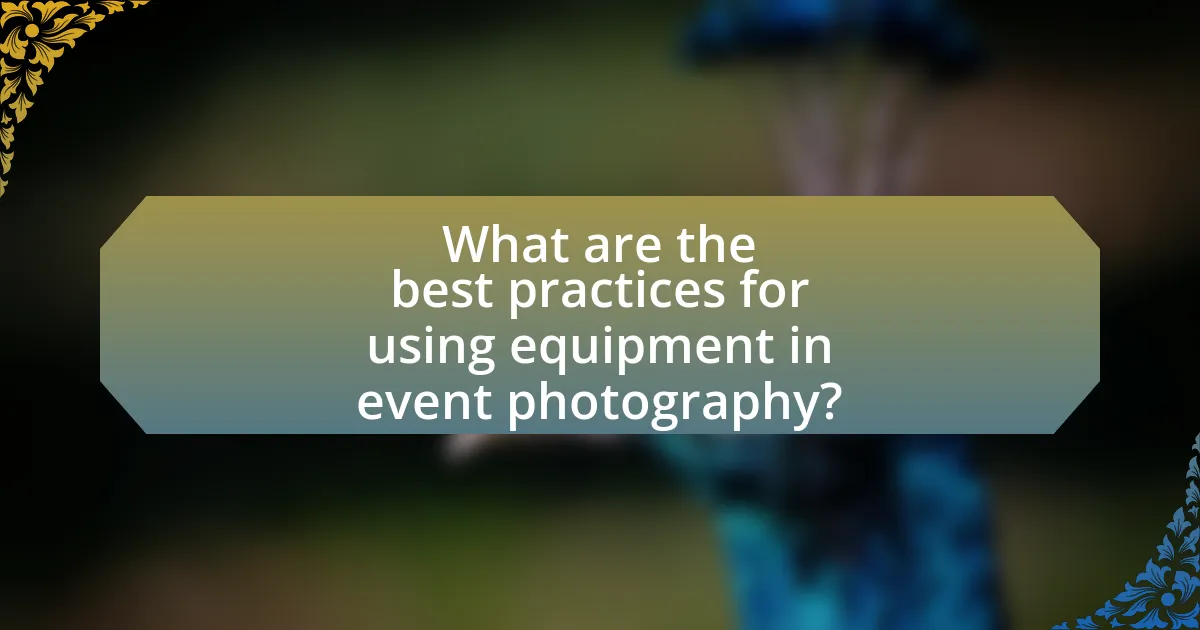
What are the best practices for using equipment in event photography?
The best practices for using equipment in event photography include ensuring proper gear selection, maintaining equipment functionality, and optimizing settings for varying conditions. Selecting the right camera and lenses, such as a DSLR or mirrorless camera with a versatile zoom lens, allows for adaptability in different environments. Regularly checking and maintaining equipment, including cleaning lenses and ensuring batteries are charged, prevents technical issues during events. Additionally, adjusting camera settings like ISO, aperture, and shutter speed based on lighting conditions enhances image quality. For instance, using a higher ISO in low-light situations can help capture clearer images without motion blur. These practices are essential for achieving professional results in event photography.
How can you effectively manage your equipment during an event?
To effectively manage your equipment during an event, implement a systematic approach that includes organization, preparation, and monitoring. Organizing your equipment involves categorizing items such as cameras, lenses, and accessories in a way that allows for quick access. Preparation entails checking all equipment before the event, ensuring batteries are charged, memory cards are formatted, and backup gear is available. Monitoring during the event includes regularly assessing the condition of your equipment and making adjustments as necessary, such as switching lenses or changing settings based on lighting conditions. This structured management approach minimizes the risk of equipment failure and enhances overall efficiency, which is crucial for capturing high-quality images in dynamic event environments.
What tips can help you quickly switch between different lenses?
To quickly switch between different lenses, use a lens pouch or belt system for easy access and organization. This method allows photographers to have multiple lenses readily available, minimizing downtime during events. Additionally, practice switching lenses in a controlled environment to build muscle memory and speed. Keeping the camera body pointed down while changing lenses can prevent dust from entering the sensor area. These techniques are widely recommended by professional photographers to enhance efficiency during fast-paced events.
How do you ensure your equipment is ready for unexpected situations?
To ensure equipment is ready for unexpected situations, regular maintenance and thorough pre-event checks are essential. This involves inspecting all gear, including cameras, lenses, and lighting, for functionality and cleanliness before each event. Additionally, carrying backup equipment, such as extra batteries and memory cards, mitigates the risk of equipment failure during critical moments. According to a survey by the Professional Photographers of America, 70% of photographers reported that having backup gear saved them from potential disasters at events.
What common mistakes should you avoid with event photography equipment?
Common mistakes to avoid with event photography equipment include not testing gear before the event, failing to bring backup equipment, and neglecting to charge batteries. Testing gear ensures functionality and familiarity, which is crucial for capturing important moments. Bringing backup equipment, such as an extra camera or lens, mitigates the risk of equipment failure during the event. Additionally, fully charging batteries before the event prevents unexpected shutdowns, which can lead to missed opportunities. These practices are essential for maintaining professionalism and ensuring high-quality results in event photography.
How can improper equipment settings ruin your event photos?
Improper equipment settings can ruin your event photos by causing issues such as incorrect exposure, focus, and color balance. For instance, if the ISO is set too high, images may appear grainy, while a low shutter speed can result in motion blur, making subjects indistinct. Additionally, incorrect white balance settings can lead to unnatural color casts, distorting the true appearance of the scene. These technical flaws can significantly detract from the quality of the photographs, making them unusable for professional purposes.
What are the risks of not having backup equipment during an event?
Not having backup equipment during an event poses significant risks, including potential equipment failure, which can lead to missed critical moments. For instance, if a camera malfunctions, the inability to capture key events can result in lost opportunities for both the photographer and the client. Additionally, the absence of backup gear can cause delays in the event schedule, as time may be wasted troubleshooting or sourcing replacements on-site. This can negatively impact the overall experience for attendees and organizers. Furthermore, without backup equipment, the photographer may face reputational damage due to an inability to deliver promised results, which can lead to loss of future business.
What practical tips can enhance your event photography experience?
To enhance your event photography experience, utilize a versatile camera with fast autofocus and a wide aperture lens to capture sharp images in varying lighting conditions. A camera like the Canon EOS R6, known for its excellent low-light performance and rapid focus, can significantly improve image quality. Additionally, using a flash or external lighting can help illuminate subjects in dim environments, ensuring clarity and detail in your photos. Practicing composition techniques, such as the rule of thirds, can also elevate the visual appeal of your shots. Lastly, being familiar with your equipment and settings allows for quick adjustments, which is crucial in dynamic event settings.
How can you prepare your equipment before the event day?
To prepare your equipment before the event day, conduct a thorough check of all gear, ensuring that cameras, lenses, batteries, and memory cards are in optimal condition. This includes cleaning lenses, charging batteries fully, and formatting memory cards to prevent data loss. Additionally, pack all necessary accessories such as tripods, flashes, and backup equipment to avoid any last-minute issues. According to industry standards, having fully functional equipment is crucial, as 70% of photographers report equipment failure as a significant concern during events.
What strategies can help you capture candid moments effectively?
To capture candid moments effectively, utilize a combination of stealth, anticipation, and the right equipment. Stealth involves minimizing your presence by using a quiet camera and avoiding intrusive behavior, allowing subjects to act naturally. Anticipation requires observing interactions and emotions to predict moments before they happen, enabling timely captures. The right equipment, such as a fast lens with a wide aperture, enhances low-light performance and allows for quick focus adjustments, which is crucial in dynamic environments. Research indicates that photographers who employ these strategies can significantly improve the quality of candid shots, as they align with the natural flow of events rather than interrupting them.










